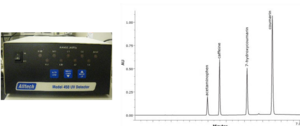Difference between revisions of "UV/Vino"
m (moved Interface HPLC UV/Vis detector with nanode to UV/Vuino: Nice name bro!) |
|||
| (6 intermediate revisions by 2 users not shown) | |||
| Line 1: | Line 1: | ||
{{Project | {{Project | ||
| − | |ProjectStatus= | + | |picture=Uvvino.png |
| + | |ProjectStatus=Dormant | ||
|ProjectNiche=Electronics | |ProjectNiche=Electronics | ||
|ProjectPurpose=World domination | |ProjectPurpose=World domination | ||
}} | }} | ||
| − | Interface older | + | Interface (older) UV/Vis detectors with a nanode instead of a chartrecorder, write interpretation software |
| − | Got a couple of different Uv/VIS detectors from the | + | Got a couple of different Uv/VIS detectors 2 are from the 80's and 1 is built more recently (>1995). One is a Varian that unfortunately exceeded its lamp burning hours and will most likely not bee operating until i get a new lamp. |
| − | + | The 2 operational ones are an Alltech 450 fixed 254 nm UV spectrometer which is designed to function as a preperative HPLC detector but should work fine as a normal UV HPLC detector. The other one is older but actually nicer since it has a dial to adjust the wavelenght. | |
| − | + | The 2 working detectors have integrator ports that read 1V at 1AU (which means 90% of all photons are absorbed) | |
| − | + | The plan is to connect these detectors to the a/d converter of the nanode, write a program for the nanode that sets set the analogReference to INTERNAL, makes it read the analog port at a defined interval and printout the 10bit value including a timestamp. Write software that reads the data provided by the nanode to interpretate the signals over a defined timeline (HPLC run time) and provide provide a textual and graphical presentation of the data acquired. | |
| − | + | Dreamer opted me to take a look and consider PySide for writing the GUI, thus i decided to take a look at PyQt and learned that PyQt is an amazing framework :) | |
| − | + | Planning: | |
| − | 4. Write a simple GUI that will draw the absorbance peaks niceley over a timeframe using | + | 1. Solder nanode kit together - Done (after sitting quietly in a corner soldering half a sunday :P). |
| + | |||
| + | 2. Measure the peak voltage at full absorbance on both spectrometers - Done | ||
| + | |||
| + | It seems that the detectors i am working with provide around 1V, but i did measure negative current. I am not planning to use the reference port for ranging my voltage but i'm not sure how well this nanode can handle an accidental low negative voltage. | ||
| + | |||
| + | 3, Write a simple program for the nanode to do the writing. - Wrote a simple program for this and will have to improve/add features now that the GUI is somewhat working. | ||
| + | |||
| + | 4. Write a simple GUI that will draw the absorbance peaks niceley over a timeframe using PyQt. - Done | ||
| + | |||
| + | [1] http://arduino.cc/en/Reference/AnalogReference | ||
Latest revision as of 02:07, 15 February 2017
| Projects | |
|---|---|

| |
| Participants | V |
| Skills | |
| Status | Dormant |
| Niche | Electronics |
| Purpose | World domination |
Interface (older) UV/Vis detectors with a nanode instead of a chartrecorder, write interpretation software
Got a couple of different Uv/VIS detectors 2 are from the 80's and 1 is built more recently (>1995). One is a Varian that unfortunately exceeded its lamp burning hours and will most likely not bee operating until i get a new lamp.
The 2 operational ones are an Alltech 450 fixed 254 nm UV spectrometer which is designed to function as a preperative HPLC detector but should work fine as a normal UV HPLC detector. The other one is older but actually nicer since it has a dial to adjust the wavelenght.
The 2 working detectors have integrator ports that read 1V at 1AU (which means 90% of all photons are absorbed)
The plan is to connect these detectors to the a/d converter of the nanode, write a program for the nanode that sets set the analogReference to INTERNAL, makes it read the analog port at a defined interval and printout the 10bit value including a timestamp. Write software that reads the data provided by the nanode to interpretate the signals over a defined timeline (HPLC run time) and provide provide a textual and graphical presentation of the data acquired.
Dreamer opted me to take a look and consider PySide for writing the GUI, thus i decided to take a look at PyQt and learned that PyQt is an amazing framework :)
Planning:
1. Solder nanode kit together - Done (after sitting quietly in a corner soldering half a sunday :P).
2. Measure the peak voltage at full absorbance on both spectrometers - Done
It seems that the detectors i am working with provide around 1V, but i did measure negative current. I am not planning to use the reference port for ranging my voltage but i'm not sure how well this nanode can handle an accidental low negative voltage.
3, Write a simple program for the nanode to do the writing. - Wrote a simple program for this and will have to improve/add features now that the GUI is somewhat working.
4. Write a simple GUI that will draw the absorbance peaks niceley over a timeframe using PyQt. - Done